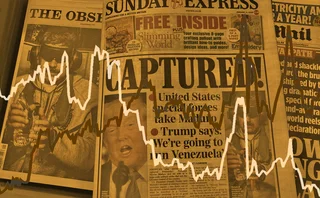
Lack of liquidity means a comeback for vol swaps
Dynamic replication of the payoff of volatility swaps on single stocks in illiquid markets is cheaper and easier than replicating variance swaps payoffs, dealers say.
Activity in variance swaps has died down after volatility spiked in late 2008, causing many dealers to experience hefty losses, particularly in single stocks. The resulting pull-back has spurred dealers to search for other ways to offer volatility trades where clients are not required to delta-hedge options. Dealers such as BNP Paribas are actively pushing volatility swaps as a viable alternative.
"The revival of the volatility swap comes from the need for a pure volatility product in markets with reduced liquidity, where variance is not an option, like Asian single stock markets," explains Paris-based Bertrand Delarue, global head of product engineering at BNP Paribas.
Volatility swaps were originally traded in the late 1990s but became less popular after the advent of variance swaps, which were considered easier to hedge. Volatility swaps pay out volatility - as opposed to variance swaps, which pay out an amount equal to the difference between realised variance (volatility squared) and a pre-agreed strike level, multiplied by the vega notional (vega is the sensitivity of an option's price to changes in volatility).
Variance swaps are typically hedged by replicating the payoff using a portfolio of vanilla options, a set of out-of-the money puts and calls on the underlying equities. In theory, a dealer is required to buy a continuum of strikes down to zero and up to infinity. For each strike, a dealer would be required to buy an amount of options inversely proportional to the square of the strike. Usually it is near impossible to find deep out-of-the-money puts or calls on a stock or index, and so the far end of the range - corresponding to very improbable high levels of volatility - are left unhedged.
The problem for dealers arises when less deeply out-of-the-money puts (30%-60%), representing relatively probable high-volatility scenarios, become illiquid. The puts hold a significant weight in the hedging portfolio, and if they can't be found, hedging the swaps in advance becomes exceptionally difficult, removing one of their main advantages over volatility swaps.
"One of the common criticisms levelled at volatility swaps is the lack of exact replication," says Delarue. "But in markets with scarce liquidity, the theoretical replication of variance swaps is just that, theoretical. In a market environment where it is difficult to find out-of-the-money strikes to hedge, dealers have to resort to dynamic replication using at-the-money volatility. Such a hedging strategy is cheaper and doable for volatility swaps - more so than for variance swaps because the vega does not increase dramatically as the volatility increases. This results in a more cost-efficient product, with tighter bid-ask spreads."
When hedging a volatility swap in illiquid option markets, dealers will typically first attempt to buy out-of-the-money strikes, as they would when hedging variance swaps, and then buy at-the-money volatility as the spot moves. If the spot drops and volatility climbs, dealers aren't required to buy as many deep out-of-the-money puts as they would to hedge a variance swap, because the vega does not move as dramatically with volatility as it does in the case of variance swaps. Vega is hedged out by employing straddles (the sale or purchase of a put option and call option, with the same strike price and same expiry).
Research from BNP Paribas compared a long volatility swap position and a long variance swap position on a European financial name, with December 2010 market prices of 38 and 43 respectively. It found that the long volatility position outperformed the long variance position in profit and loss terms for realised volatilities between 22 and 64.
"There are valid grounds for pushing volatility swaps rather than variance swaps," said Gilles Dahan, head of equity derivatives trading for Europe, the Middle East and Africa at Citi in London. "The dynamic behaviour of volatility swaps is less aggressive, in that dealers will be less exposed to volatility convexity and skew than they would trading a variance swap. But it is important to note that a volatility swap remains an exotic product, and maintaining a competent hedge in all market conditions will take a good deal of effort."
However, despite some dealers attempting to offer new alternatives, some market participants believe that both variance and volatility swaps on single stocks are still too exotic for many firms, and will maintain a very low profile for the time being. "Dealers got badly burnt replicating variance swaps, and therefore it will take time before dealers start facilitating any kind of new light exotic payoffs, including volatility swaps," said one head of exotic index trading in London. "In addition, liquidity on single stocks is so poor that it would seriously weigh on dealers' abilities to provide these types of trades."
See also: An aversion to variance
SG CIB tries to fix variance swap flaws
Popular volatility indexes plunge
Higher and higher
Only users who have a paid subscription or are part of a corporate subscription are able to print or copy content.
To access these options, along with all other subscription benefits, please contact info@risk.net or view our subscription options here: http://subscriptions.risk.net/subscribe
You are currently unable to print this content. Please contact info@risk.net to find out more.
You are currently unable to copy this content. Please contact info@risk.net to find out more.
Copyright Infopro Digital Limited. All rights reserved.
As outlined in our terms and conditions, https://www.infopro-digital.com/terms-and-conditions/subscriptions/ (point 2.4), printing is limited to a single copy.
If you would like to purchase additional rights please email info@risk.net
Copyright Infopro Digital Limited. All rights reserved.
You may share this content using our article tools. As outlined in our terms and conditions, https://www.infopro-digital.com/terms-and-conditions/subscriptions/ (clause 2.4), an Authorised User may only make one copy of the materials for their own personal use. You must also comply with the restrictions in clause 2.5.
If you would like to purchase additional rights please email info@risk.net
More on Markets
S&P bull run drives interest in reset and lookback hedges
Variable strike put options proved popular alternative hedging format of 2025
US mutual funds slash short euro positions at record pace
Counterparty Radar: Pimco cut $4.6bn of EUR/USD puts in Q3 amid changing stance on dollar direction
Nomura hires new global eFX head
Mark McMillan to oversee e-trading and sales activities in newly created role
Trump’s LatAm gambit spurs FX hedging rush
Venezuela op boosts risk reversals as investors look to protect carry trades
One Trading brings 24/7 equity trading to Europe
Start-up exchange will launch perpetual futures Clob in Q1 after AFM nod
FXGO volumes surge despite fee switch-on
Dealers split on whether levy is behind volume increases across SDPs
Banks hope new axe platform will cut bond trading costs
Dealer-backed TP Icap venture aims to disrupt dominant trio of Bloomberg, MarketAxess and Tradeweb
Kyriba sees uptake in AI-assisted FX hedging tools
Automated data collection and cleaning helps corporates create better hedges and has cut unexplained P&L moves by 87%, says vendor







